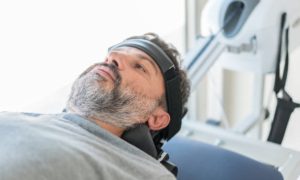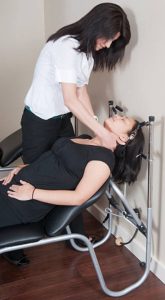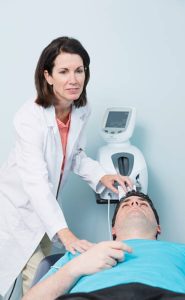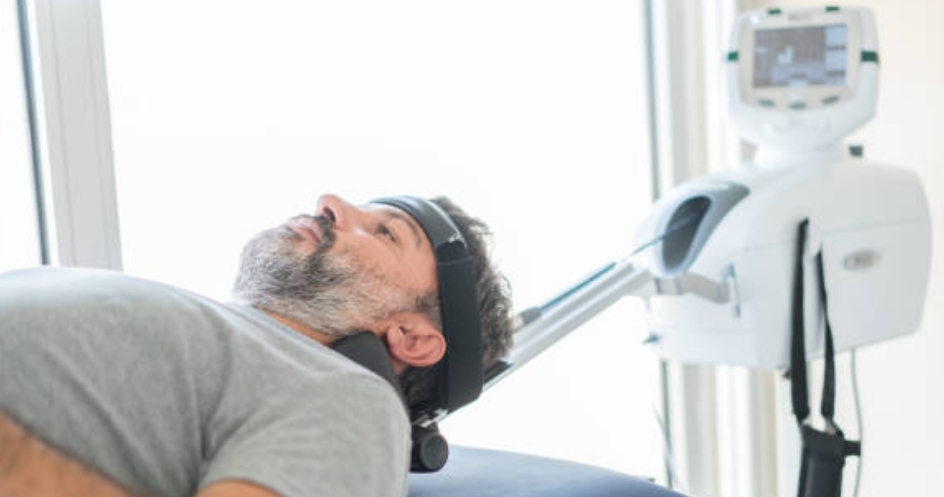Management of cervical radicular syndromes can involve surgical or conservative approaches. Evidence suggests that while surgery may provide faster pain relief compared to physical therapy or hard-collar immobilization, there is minimal difference in long-term outcomes (Carragee EJ, et al. 2010). Cervical traction therapy, often part of rehabilitation programs, applies a distracting force to the cervical spine to relieve nerve root compression caused by intervertebral discs. Despite its frequent use, a systematic review found insufficient evidence to confirm its efficacy due to poor methodological quality of available studies (Graham N, et al. 2008; Boyles R, et al. 2011). Research on the optimal angles of cervical traction, particularly for influencing the Hoffmann’s reflex (H-reflex) in patients with lower cervical disc disruption, could guide rehabilitation strategies for cervical discogenic radiculopathy. Although ventroflexion traction is considered effective for lower cervical spine treatment, studies report conflicting outcomes regarding its impact on chronic cervical radiculopathy (Young IA, et al. 2009; Graham N, et al. 2006; Borman P, et al. 2008; Chiu TT, et al. 2011). Intermittent traction, however, showed short-term benefits for reducing pain in patients with chronic neck pain and radiating symptoms (Graham N, et al. 2013).

In a randomized clinical trial, Moustafa IM and Diab AA (2014) demonstrated that a multimodal program combined with a novel traction method significantly improved outcomes such as the Neck Disability Index (NDI), neck and arm pain, and the amplitude and latency of the flexor carpi radialis (FCR) H-reflex. The study identified that a cervical extension angle of 5° achieved maximum improvements. Similarly, Hegazy MM, et al. (2019) reported that combining intermittent cervical traction with median nerve mobilization significantly reduced FCR H-reflex latency in patients with unilateral cervical radiculopathy. Hassan MMA, et al. (2024) compared various traction positions in patients with C5–C7 disc protrusion and found that decompression traction from a neutral position with a 0° rope angle or from a foraminal opening direction showed significant improvements in NDI, pain levels, and FCR H-reflex amplitude.

Several factors influence the effectiveness of cervical traction, including force, duration, and angle. Research indicates that positions with cervical flexion of 25°–35° increase the intervertebral space, particularly in segments C4–C7, with neutral or slightly flexed positions being most effective (Wong AM, et al. 1992; Hseuh TC, et al. 1991). Traction performed in a supine position has also been found to enhance vertebral separation and reduce muscle tension compared to sitting (Fater and Kernozek, 2008). Raney NH, et al. (2009) identified clinical prediction rules to determine patients most likely to benefit from cervical traction, highlighting factors such as age >55 years, positive upper limb tension tests, and specific mobility findings.
Conclusion
Research suggests that cervical traction is most effective when performed in a supine position with appropriate angles of flexion or extension, depending on the targeted cervical segment. Positions such as 5° extension, 25°–35° flexion, and neutral or foraminal opening postures are recommended for optimizing therapeutic outcomes. Multimodal approaches incorporating traction with other interventions like nerve mobilization or strengthening exercises may further enhance clinical benefits.
Learning Points
- Effectiveness: Intermittent traction is more effective than continuous traction for short-term pain relief in chronic cervical radiculopathy.
- Position: Supine traction positions allow for greater vertebral separation and reduced muscle tension compared to sitting.
- Angles: Neutral, slightly flexed (25°–35°), and specific extension (e.g., 5°) angles are associated with optimal therapeutic outcomes.
- Multimodal Programs: Combining traction with other interventions, such as nerve mobilization and strengthening, enhances overall effectiveness.
- Patient Selection: Clinical prediction rules can help identify patients most likely to benefit from cervical traction.
Recommendations for Traction Positions

- Neutral Position with 0° Rope Angle: Effective for general decompression.
- 25°–35° Flexion: Increases intervertebral space in mid to lower cervical spine (C4–C7).
- 5° Extension: Maximizes improvements in NDI and H-reflex in specific cases.
- Foraminal Opening Posture: Combining flexion, lateral bending, and rotation to relieve nerve root compression.
- Supine Position: Preferred for minimizing muscle tension and enhancing vertebral separation.
- Avoid Excessive Flexion: Gradual force increases are recommended to prevent stress on posterior annulus fibers.
References:
1. Borman P, Keskin D, Ekici B, Bodur H. The efficacy of intermittent cervical traction in patients with chronic neck pain. Clin Rheumatol. 2008;27(10):1249–53.
2. Boyles R, Floy P, Mellon J Jr, Hayes M, Hammer B. Effectiveness of manual physical therapy in the treatment of cervical radiculopathy: a systematic review. J Man Manip Ther. 2011;19(3):135–42.
3. Carragee EJ, Hurwitz EL, Cheng I, Carroll LJ, Nordin M, Guzman J, Peloso P, Holm LW, Côté P, Hogg-Johnson F, van der Velde G, Cassidy JD, Haldeman F; Bone and Joint Decade 2000–2010 Task Force on Neck Pain and Its Associated Disorders. Treatment of neck pain: injections and surgical interventions: results of the Bone and Joint Decade 2000–2010 Task Force on Neck Pain and Its Associated Disorders. Spine. 2008;33(Suppl. 4):153–69. doi:10.1097/BRI.0b013e31816445ea.
4. Chiu TT, Ng JK, Walther-Zhang B, Lin RJ, Ortelli L, Chua SK. A randomized controlled trial on the efficacy of intermittent cervical traction for patients with chronic neck pain. Clin Rehabil. 2011;25(9):814–22.
5. Fater DCW, Kernozek TW. Comparison of cervical vertebral separation in the supine and seated positions using home traction units. Physiother Theory Pract. 2008;24(6):430–6.
6. Graham N, Gross A, Goldsmith CH, Klaber Moffett J, Haines T, Burnie SJ. Mechanical traction for neck pain with or without radiculopathy. Cochrane Database Syst Rev. 2008.
7. Graham N, Gross AR, Carlesso LC, et al. An ICON overview on physical modalities for neck pain and associated disorders. Open Orthop J. 2013;7:440–60.
8. Graham N, Gross AR, Goldsmith C. Mechanical traction for mechanical disorders: A systematic review. J Rehabil Med. 2006;38:145–52.
9. Gudavalli S, Kruse RA. Foraminal stenosis with radiculopathy from a cervical disc herniation in a 33-year-old man treated with flexion distraction decompression manipulation. J Manipulative Physiol Ther. 2008;31:376–80.
10. Hassan MMA, Hanafy AF, Hassan SH, Abdelmeged SM, Elhafez SM. Which is better to decompress the nerve roots in cervical radiculopathy: stretching or traction from foraminal opening position? Physiother Quart. 2024;32(3):52–62.
11. Hegazy MM, Gomaa EF, Abd El Mageed SF, El Habashy HR. H-reflex latency changes after combined application of traction and neural mobilization in cervical radiculopathy. Egypt J Neurol Psychiatry Neurosurg. 2019;55:69. doi:10.1186/s41983-019-0113-8.
12. Humphreys SC, Chase J, Patwardhan A, Schuster J, Lomasney L, Hodges SD. Flexion and traction effect on C5–C6 foraminal space. Arch Phys Med Rehabil. 1998;79(9):1105–9.
13. Humphreys SC, Hodges SD, Patwardhan A, Eck JC, Covington LA, Sartori M. The natural history of the cervical foramen in symptomatic and asymptomatic individuals aged 20–60 years as measured by magnetic resonance imaging. Spine. 1998;23(20):2180–4.
14. Jellad A, Salah ZB, Boudokhane S, Migaou H, Bahri I, Rejeb N. The value of intermittent cervical traction in recent cervical radiculopathy. Ann Phys Rehabil Med. 2009;52(9):638–52.
15. Joghataei MT, Arab AM, Khaksar H. The effect of cervical traction combined with conventional therapy on grip strength on patients with cervical radiculopathy. Clin Rehabil. 2004;18:879–87.
16. Khan RR, Awan WA, Rashid F, Masood F. A randomized controlled trial of intermittent cervical traction in sitting vs. supine position for the management of cervical radiculopathy. Pak J Med Sci. 2017;33(6):1333–8.
17. Kruse RA, Imbarlina F, De Bono VF. Treatment of cervical radiculopathy with flexion distraction. J Manipulative Physiol Ther. 2001;24:206–9.
18. Liu J, Ebraheim NA, Stanford CG Jr, Patil V, Elsamaloty H, Brehm K, Farrell F. Quantitative changes in the cervical neural foramen resulting from axial traction: in vivo imaging study. Spine J. 2008;8(4):619–23.
19. Moustafa IM, Diab AA. Multimodal treatment program comparing 2 different traction approaches for patients with discogenic cervical radiculopathy: a randomized controlled trial. J Chiropr Med. 2014;13(3):157–67. doi:10.1016/j.jcm.2014.07.003.
20. Muhle C, Resnick D, Ahn JM, Sudmeyer M, Heller M. In vivo changes in the neuroforaminal size at flexion-extension and axial rotation of the cervical spine in healthy persons examined using kinematic magnetic resonance imaging. Spine. 2001;26(13):287–93.
21. Sari H, Akarirmak Ü, Karacan I, Akman H. Evaluation of effects of cervical traction on spinal structures by computerized tomography. Adv Physiother. 2003;5(3):114–21.
22. Thoomes EJ, Scholten-Peeters W, Koes B, Falla D, Verhagen AP. The effectiveness of conservative treatment for patients with cervical radiculopathy: a systematic review. Clin J Pain. 2013;29:1073–86.
23. Vaughn HT, Having KM, Rogers JL. Radiographic analysis of intervertebral separation with a 0 degrees and 30 degrees rope angle using the Saunders cervical traction device. Spine. 2006;31(2):39–43.
24. Wong AM, Leong CP, Chen CM. The traction angle and cervical intervertebral separation. Spine. 1992;17(2):136–8.
25. Wong JJ, Côté P, Quesnele JJ, Stern PJ. The course and prognostic factors of symptomatic cervical disc herniation with radiculopathy: a systematic review of the literature. Spine J. 2014;14(8):1781–9.
26. Wong LK, Luo Z, Kurusu N. The effect of traction position in cervical traction therapy based on dynamic simulation models. J Biomed Sci Eng. 2017;10:243–56. doi:10.4236/jbise.2017.105019.
